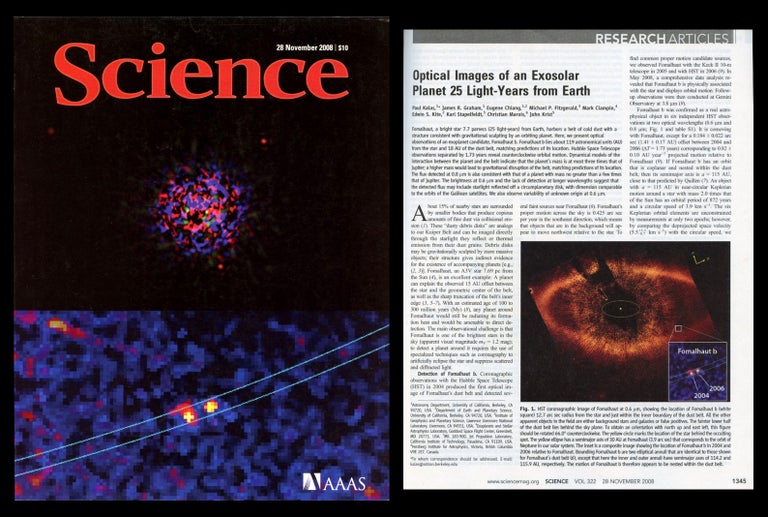Optical Images of an Exosolar Planet 25 Light-Years from Earth in Science, 322, 5906, 28 November, 2008, pp. 1345-1348
New York: AAAS, 2008. 1st Edition. FIRST EDITION IN ORIGINAL WRAPS OF THE FIRST PAPER TO SHOW & DESCRIBE THE OPTICAL IMAGING OF AN EXTRASOLAR PLANET, a Jupiter-sized planet orbiting the star Fomalhaut . The work is a “landmark [discovery], as it reports the first definitive, direct imaging of exoplanets: the planets that orbit distant stars,” (Alberts, Science editor-in-chief on Kalas Berkeley website). ”The image of Fomalhaut, its visually striking belt of comet dust and its planet has become an iconic image of a planetary system” (Kalas).
Fomalhaut is a bright star 25 light years from Earth and imagine was provided by the Hubble Space Telescope. Estimated to be no more than three times Jupiter's mass, the planet, called Fomalhaut b, orbits the bright southern star Fomalhaut [which is] located 25 light-years away in the constellation Piscis Australis, or the ‘Southern Fish.’
“Seeing an extrasolar planet directly was one of the last and most speculative goals of the Hubble Space Telescope when it was put in orbit in 1990” (Weiler, Washington Post interview 11.13.2008). The direct result of technical advances in both imagine and data analysis, the Hubble images show the belt of dust and debris (bright oval) surrounding the star Fomalhaut.
The planet orbits the star every 872 years and sculpts the inner edge of the belt. A coronagraph [onboard the Hubble] was used to block out the light of the star, which is 100 million times brighter than the planet. Kalas and his team were able to find the image by looking at two succeeding years. This technique rendered the motion of the planet detectable; “indeed it seems to be moving in an orbit nested within the dust belt” (Kalas 2008).
Another team, Christian Marois, et. al, published similar work at the same time; publication online was simultaneous and credit has been given to both teams. Both teams were awarded the AAAS Newcomb Cleveland Prize for outstanding papers in the journal Science. This is the first time this award has been given in the field of astronomy since 1999," Kalas said. "Considering the number of papers that Science publishes weekly on many vital scientific topics, it's a tremendous honor to be selected” (Kalas, Berkeley website). Item #1468
CONDITION & DETAILS: New York: AAAS. Complete 1st edition in original wraps, complete. 8vo. Very slight scuffing. Very good condition.
Price: $200.00

